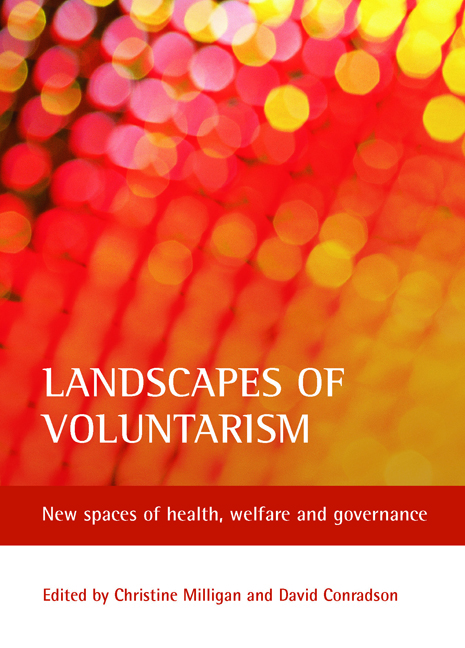Book contents
- Frontmatter
- Contents
- List of tables, figures, maps and plates
- Notes on contributors
- Foreword: Beyond the shadow state?
- one Contemporary landscapes of welfare: the ‘voluntary turn’?
- two A ‘new institutional fix’? The ‘community turn’ and the changing role of the voluntary sector
- three Renewal or relocation? Social welfare, voluntarism and the city
- four Voluntarism and new forms of governance in rural communities
- five New times, new relationships: mental health, primary care and public health in New Zealand
- six Informal and voluntary care in Canada: caught in the Act?
- seven Competition, adaptation and resistance: (re)forming health organisations in New Zealand’s third sector
- eight The difference of voluntarism: the place of voluntary sector care homes for older Jewish people in the United Kingdom
- nine Values, practices and strategic divestment: Christian social service organisations in New Zealand
- ten Faith-based organisations and welfare provision in Northern Ireland and North America: whose agenda?
- eleven Government restructuring and settlement agencies in Vancouver: bringing advocacy back in
- twelve Developing voluntary community spaces and Ethnicity in Sydney, Australia
- thirteen The voluntary spaces of charity shops: workplaces or domestic spaces?
- fourteen The changing landscape of voluntary sector counselling in Scotland
- fifteen Volunteering, geography and welfare: a multilevel investigation of geographical variations in voluntary action
- sixteen Reflections on landscapes of voluntarism
- Index
eleven - Government restructuring and settlement agencies in Vancouver: bringing advocacy back in
Published online by Cambridge University Press: 15 January 2022
- Frontmatter
- Contents
- List of tables, figures, maps and plates
- Notes on contributors
- Foreword: Beyond the shadow state?
- one Contemporary landscapes of welfare: the ‘voluntary turn’?
- two A ‘new institutional fix’? The ‘community turn’ and the changing role of the voluntary sector
- three Renewal or relocation? Social welfare, voluntarism and the city
- four Voluntarism and new forms of governance in rural communities
- five New times, new relationships: mental health, primary care and public health in New Zealand
- six Informal and voluntary care in Canada: caught in the Act?
- seven Competition, adaptation and resistance: (re)forming health organisations in New Zealand’s third sector
- eight The difference of voluntarism: the place of voluntary sector care homes for older Jewish people in the United Kingdom
- nine Values, practices and strategic divestment: Christian social service organisations in New Zealand
- ten Faith-based organisations and welfare provision in Northern Ireland and North America: whose agenda?
- eleven Government restructuring and settlement agencies in Vancouver: bringing advocacy back in
- twelve Developing voluntary community spaces and Ethnicity in Sydney, Australia
- thirteen The voluntary spaces of charity shops: workplaces or domestic spaces?
- fourteen The changing landscape of voluntary sector counselling in Scotland
- fifteen Volunteering, geography and welfare: a multilevel investigation of geographical variations in voluntary action
- sixteen Reflections on landscapes of voluntarism
- Index
Summary
Introduction
The election of a series of neoliberal governments in the 1980s and 1990s led to a sea change in government relations with voluntary organisations in Canada (Brock and Banting, 2001). The Canadian government has funded voluntary organisations since the 1940s, when it first recognised their potential for nation building by funding activities related to ‘citizenship training’ (Phillips, 2001). Funding expanded over the next three decades: charities were supported through the tax system, direct funding was provided to groups promoting aspects of ‘Canadian identity’ and voluntary organisations were included in public consultations (Brock and Banting, 2001; Phillips, 2001). Relations began to deteriorate in the 1980s, however, with the election of two Conservative governments under Brian Mulroney (1984 and 1988). The Conservatives launched selective cuts to the voluntary sector, attacking advocacy-oriented organisations critical of neoliberal policies and branding them as ‘special interest groups’ (Phillips, 2001). The subsequent election of a Liberal government under Jean Chretien (1993) ushered in deeper funding cuts, a shift from core to short-term project funding, and voluntary organisations were firmly shut out of further policy consultations (Phillips, 2001).
During the second Chretien term (1997), however, the federal government changed its stance on voluntary organisations. The Liberals adopted Tony Blair's ‘third way’ approach and began to forge a new relationship with the sector (Phillips, 2001). Funding cuts continued, but public policy soon hinged on an enhanced role for the voluntary sector, now envisioned as ‘a vital third pillar in Canadian society, working alongside the public and private sectors to make Canada a more humane, caring and prosperous nation’ (Canadian Privy Council, cited in Chappell, 2001, p 118). The Voluntary Sector Initiative followed, bringing together representatives of government and voluntary organisations to draft a new Accord (Phillips, 2003a, 2003b). Phillips (2003a, 2003b) observes that the Voluntary Sector Initiative marks a shift from a model of top-down ‘government’ to a model of ‘governance’ where the state works collaboratively with partners. Still, it must be noted, the voluntary sector does not enter this partnership on an equal footing with government.
The Canadian voluntary sector depends on 1.6 million volunteers and over 1.3 million employees, providing paid employment to 9% of the country's workforce (Hall and Banting, 2000, p 15; Chappell, 2001, pp 114, 118). With nearly two thirds of voluntary sector revenues coming from government, funding cuts created a deep ‘fiscal crisis’ in the sector (Chappell, 2001, p 116).
- Type
- Chapter
- Information
- Landscapes of VoluntarismNew Spaces of Health, Welfare and Governance, pp. 191 - 208Publisher: Bristol University PressPrint publication year: 2006



